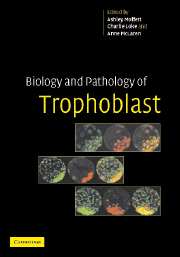Book contents
- Frontmatter
- Contents
- List of contributors
- List of participants
- Preface
- Chair's introduction
- 1 Trophoblast cell fate specification
- 2 Stem cells: pluripotency and extraembryonic differentiation in the mouse
- 3 Epigenetic regulation of trophoblast development
- 4 Regulation of X-chromosome inactivation in relation to lineage allocation in early mouse embryogenesis
- General discussion I
- General discussion II
- Final general discussion
- Index
- Plate section
- References
2 - Stem cells: pluripotency and extraembryonic differentiation in the mouse
Published online by Cambridge University Press: 07 August 2009
- Frontmatter
- Contents
- List of contributors
- List of participants
- Preface
- Chair's introduction
- 1 Trophoblast cell fate specification
- 2 Stem cells: pluripotency and extraembryonic differentiation in the mouse
- 3 Epigenetic regulation of trophoblast development
- 4 Regulation of X-chromosome inactivation in relation to lineage allocation in early mouse embryogenesis
- General discussion I
- General discussion II
- Final general discussion
- Index
- Plate section
- References
Summary
Abstract. Two distinct classes of stem cell lines can be derived from the mouse blastocyst: embryonic stem (ES) cells and trophoblast stem (TS) cells. Embryonic stem cells can differentiate into all embryonic lineages and extraembryonic mesoderm in chimeras, but are strictly excluded from the trophoblast lineage and rarely contribute to extraembryonic endoderm. In contrast, TS cells have the capacity to populate all trophoblast lineages, but are unable to make embryonic tissues or extraembryonic mesoderm and endoderm. A novel class of blastocyst-derived lines representative of the primitive endoderm lineage have been derived and characterised. Extraembryonic endoderm (XEN) cell lines contribute to derivatives of the primitive endoderm in vivo, but not to epiblast or trophoblast tissues. The signals required to maintain XEN cells in culture are not well characterised. However, the signals and critical transcription factors required for maintenance of ES and TS cell cultures have been partially determined. Embryonic stem cells require signalling through at least two pathways. The first is activated by leukaemia inhibitory factor (LIF) and transduced through the cell-surface receptor, gp130, and the intracellular protein, signal transducer and activator of transcription 3 (STAT3). The second pathway leads to activation of Smad proteins, which may be mediated by several factors, including bone morphogenetic proteins (BMPs). In contrast, TS cells require signalling from fibroblast growth factors (FGFs) and activation of mitogen-activated protein kinases (MAPKs).
- Type
- Chapter
- Information
- Biology and Pathology of Trophoblast , pp. 15 - 32Publisher: Cambridge University PressPrint publication year: 2006

